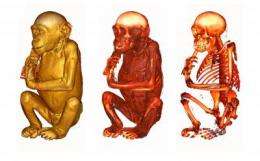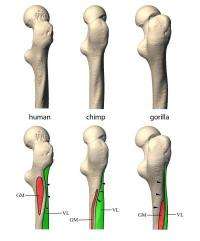Long bone shape: A family affair

Although humans and chimpanzees move quite differently, muscle attachment sites at their thighbones are similar. This result, which has recently been published by anthropologists of Zurich University in the scientific journal Anatomical Record, has major consequences for the interpretation of fossil hominid finds.
PhD student Naoki Morimoto, member of the Computer-Assisted Paleoanthropology group of Ch. Zollikofer and M. Ponce de León, and junior author of the study, was surprised by his own findings. Although humans are bipeds, and chimps are quadrupeds, muscle attachment sites at their thighbones are quite similar. Attachment sites differ substantially, however, between chimpanzees and gorillas, although these great apes species move similarly. Interestingly, Morimoto's results are in line with insights from genetics: humans and chimps are evolutionary sister species, while gorillas are more distant relatives, like cousins. Morimoto explains the seeming paradox of his results: this is not «form follows function», but «form follows family».
Functional inferences: a cautionary tale
The new findings have far-reaching implications for the interpretation of fossil hominin remains. Fossil thighbone shafts are often well preserved, but it now appears that inferences about locomotor behavior must be drawn with caution, while inferences about the fossil's evolutionary relationships might be more straightforward. Anthropologist Ch. Zollikofer explains: «the transition from great-ape-like quadrupedal to human-like bipedal locomotion is accompanied by several changes in the hip and thighbones, but currently we cannot infer functional change from structural change with any certainty.» And he asks the next big question of paleoanthropology: «Why did the last common ancestor of humans and chimps, who might have lived 7-8 million years ago, evolve novel thighbone features?»

Virtual dissection
To get a detailed look at great ape musculoskeletal anatomy, the research team combined high-resolution computed tomography with computer-assisted virtual dissection. Great ape bodies are a scarce and valuable resource for scientific studies, and anthropologists are increasingly reluctant to «sacrifice» them for anatomical dissections. Virtual autopsy – or Virtopsy – is the method of choice. Virtopsy was pioneered by Michael Thali (Institute of Forensic Science, UZH), and is now used in forensic institutes worldwide. Anthropological virtopsy has enormous potential, as it permits virtual dissection of one single specimen by many different researchers, and according to many different criteria, without actually deteriorating the orginal body. Moreover, great ape virtopsy gives an immediate picture of the spatial relationships between soft and hard tissues (bones) of one and the same individual. Traditionally, bone morphology was studied on dry-skeleton specimens, and subsequently combined with muscle data obtained from dissections of other animals.
More information: Naoki Morimoto, Marcia S. Ponce De Leon, Takeshi Nishimura and Christoph P.E. Zollikofer: Femoral Morphology and Femoropelvic Musculoskeletal Anatomy of Humans and Great Apes: A Comparative Virtopsy Study, in: The Anatomical Record, 294:1433-1445 (2011), DOI 10.1002/ar.21424
Provided by University of Zurich

















